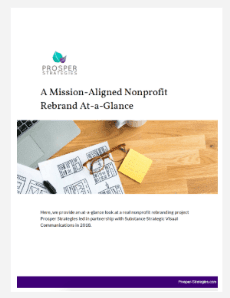We all know stakeholder engagement, particularly in the social sector, plays a critical role in developing a strong brand and message as well as advancing mission and social change. But when and how stakeholder engagement takes place contributes to both its effectiveness and the outcomes your nonprofit is aiming to achieve.
The following are recommendations for structuring stakeholder engagement in your communications and marketing efforts, and beyond.
Define what inputs you need from each stakeholder group
When you have an initiative at your nonprofit where stakeholder engagement is going to be critical, such as a rebrand or messaging project, start by defining who needs to be involved in the process and what it is that you need from your board, funders, staff, clients, or any other stakeholder group important to your organization. Is it an assessment of their perspectives today or their ideas for the future? Or do you want them to weigh in on something you’re considering or something you’ve already done?
For example, many organizations considering a rebrand will engage stakeholders in a study of risks and rewards. They will survey audiences to determine their perceptions and understanding of their brand today and their affinity toward it. When nonprofits are creating new messaging, most like to hear from their stakeholders about how they perceive the organization’s current communications and strengths to determine what needs to be carried through or clarified with new messaging.
Thinking through what it is you want from each of your stakeholder groups will inform how you best engage them.
Define how stakeholder engagement will take place
When you know what you want to learn from your stakeholders, determine the level at which each group needs to be involved in giving inputs. While you always want your stakeholders to feel heard, you don’t want to get into a situation where everyone feels like they have a vote.
Surveys are a fantastic way to get information from many – this is a tool often used with volunteers, staff or clients. Surveys are also great for collecting quantitative data over qualitative data. If you need specific input from specific stakeholders regarding certain topic areas, focus groups allow you to have more fluid conversations, giving you deeper and more personal inputs. If you want the opinions of specific individuals, such as staff leaders, funders, policymakers or others, consider one-on-one interviews.
Determine where in the process stakeholder engagement is most needed
Since stakeholder engagement is so important, it’s not something you want to do off the cuff. The best processes engage stakeholders strategically throughout. For example, you might conduct a survey at the onset of an initiative to get a baseline of perspectives from a wide array of people, then you might explore topics or issues more deeply through a focus group and confirm things through a one-on-one interview. You might also conduct a survey or interviews to inform your work at the onset, and then engage a focus group once new branding or messaging is developed to get feedback and insights on the direction you’re considering. You’ll want to determine your process for stakeholder engagement before launching into your initiative and remember, once you engage stakeholders you also need to take care to provide them with the appropriate amount of information throughout the rest of the process.
[bctt tweet=”Since stakeholder engagement is so important, it’s not something you want to do off the cuff. The best processes engage stakeholders strategically throughout.” username=”ProsperStrat”]
Developing a structured way for people to engage in your work, and defining it ahead of time ensures you’re getting what you need from stakeholders to inform your work. Most importantly, gathering insights throughout the process builds cohesion and buy in, leading to more successful outcomes.
What does a modern, mission-aligned nonprofit rebrand look like?

Prosper Strategies led a nonprofit rebrand project for Resilience, formerly known as Rape Victim Advocates, in partnership with Substance Strategic Visual Communications. Here’s an at-a-glance look at that rebrand process, including why Resilience chose to rebrand and how their new brand better aligned with their mission.